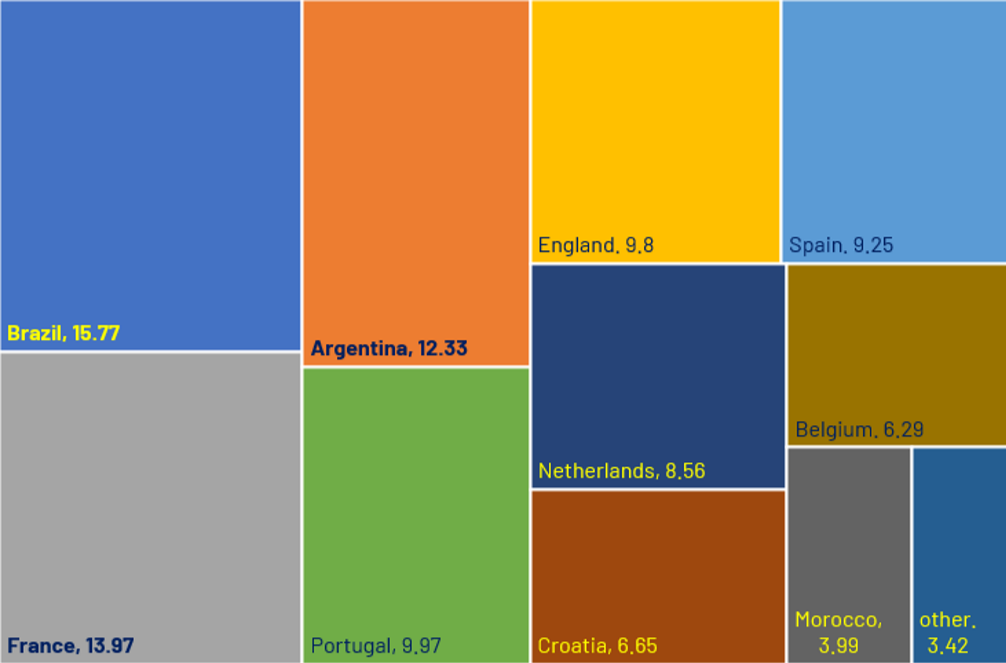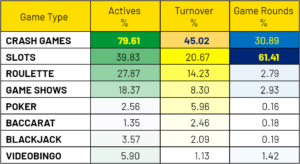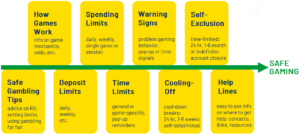Once every four years, the green-yellow jersey unites everyone in Brazil, becoming a source of national pride. Across demographics, lifestyles and political views, fans focus religiously on the games.
Our research team breaks down KTO aggregate data from the last few months of 2022 to examine how passion and football know-how impact betting markets during big sporting events.
What we have seen is that Brazilian bettors:
- – Know much about the leading teams but explore their options with the Seleção, above all;
- – Consider bets ahead of time and are not afraid of multiple bets and complex markets;
- – Game-day bets have a dominant share, with live bet shares higher for top-rated matches.
The Cult of Football in Brazil
The fact that Brazil is a football-crazed nation is no secret to anyone. It’s not uncommon to see businesses close early or shut down entirely during important matches, particularly those of the national team.
High-profile games also generate a significant impact on the economy. The Brazilian Association of Bars and Restaurants in Rio (Abrasel) claims that turnover increases by at least 30% during the World Cup, usually lasting a month. Fans flock to bars and restaurants to watch the games and celebrate with friends and family.
The love for football is deeply ingrained in Brazilian culture and is passed down generations. The anticipation for the World Cup – once every four years – takes the excitement and pride to another level.
This is exactly what we have seen on KTO in terms of betting activity, the diversity of sportsbook markets (bet types) and the behavior of registered users in relation to important World Cup games.
The World Cup as the Apex of 2022 Sports Betting
The World Cup is the pinnacle of excitement for Brazilian football fans. Many plan their lives around the event, reliving the nation’s 5 World titles and dreaming of new victories.
Young and old alike buy flags, shirts, collect player stickers. Preparations include street decorations, get-togethers and annual work leaves.
Despite the odd timing in 2022, from November 20 to December 18 the country was still expected to come to a standstill in many aspects. The densely populated centers of Rio de Janeiro, Sao Paulo – just like many other cities – are often described as “ghost towns” around peak game times.
On the contrary, it turned out to be a hectic time for sports betting enthusiasts, a pastime that was formally legalized in 2018. Soon after the run-off of the highly contested Presidential elections, real-money gamers turned to the nation’s favorite diversion.
Unfortunately for the local fans, they had to swallow an exit on penalties against Croatia (eventual bronze-medal winners and vice-champions last time around) at the ¼-final stage. Still, it was inevitably an eventful betting “season” reflecting the game schedule and popularity of teams involved.
Top-Rated Teams Get the Most Media Hype and Bets
The table below reveals the share of active users, number of bets and overall stakes placed on the top 10 teams before and during the World Cup betting sessions.

The most bets, actives and amounts placed on Brazil are more than expected. Over two-thirds (67.23%) of all players have acted upon their knowledge, passion or insights about the national team’s performances at the World Cup.
Altogether, 96.58% of the bets at the World Cup involved the above 10 teams. They also generated just under half of all stakes (48.3%) placed before and during the campaign.
We need to emphasize that these are not bets placed only during the competition but for most part of 2022. We measure betting activity on KTO starting April 1.
Argentina, the Canarinhas’ southwestern neighbors and biggest rivals, come second in terms of total stakes placed. Whatever fans may think about the Argentinians’ leader and best player, Lionel Messi, he always draws crowds’ attention with his playing style and numerous records in the game. Brazilian kids have their own idols from the national team but Messi surely gets plenty of media coverage and, accordingly, bets.
France, the reigning champions at the time, came ahead of Argentina in terms of active bettors and number of bets. In any case, both teams are not far off each other in most indicators. France had a strong squad, a mixture of young emerging athletes and experienced leaders from a winning campaign in 2018.
All of the above factors logically generated quite a lot of online sportsbook traction for the Blues. Even neutral fans expected them to go far in the tournament, which they did, reaching the Final along with Argentina. Staying in the tournament for its entire duration drove numbers up for both teams.
Similar considerations have affected betting activity on teams like England, Spain and Portugal. A number of high-profile athletes and consistent performances over the past decade are at the basis of a growing media frenzy and related fan expectations. Moreover, Portugal had the other active legend of the game, Cristiano Ronaldo, in what was likely his last World Cup campaign.
Outside the top 6, some of the other teams generated a lot of movement simply because of their high FIFA rankings. Belgium headed that list for a long time until 2022 (when Brazil took over), enjoying what was dubbed as their nation’s “golden generation”. The Red Devils had also finished 3rd last time around.
On the other hand, teams moved up the betting activity charts when they reached the latter stages of the World Cup. Morocco was the tournament surprise, getting to the semi-finals but losing to Croatia for third place. The Netherlands faced the future World Champions in the ¼-finals, taking Messi and co. to penalty shootouts.
Most Popular Bet Types at the 2022 World Cup
The graph above ranks the most common betting markets – that is to say types of bets – that reveal a lot about user choices and behavior before and during last year’s World Cup.
Just as with the most popular teams (see above), the shares of active players exceed 100% simply because fans bet on more than one market, team and game outcome. The number of bets add up to 100% while stakes for the top markets fall below (at 86.5%) since they spread out into system and multiple bets.
We clearly see that the ultimate outcome of a game is the most frequently chosen betting market – the result going in favor of one particular team or the game ending in a draw. The 1X2 market has been tried by almost every single active player (94.74%), generating around two thirds of bets (70.50%) and stake amounts (61.90%).
In a way, “overall outcome” bets are a gateway for more casual players, including those who join the real-money gaming scene for big events (like the World Cup) and national team matches.
The amount of total goals in a game is also an attractive market for over a third of actives (36.87%), generating just under 10% of bets and stakes. Similar binary markets also get substantial traction: “both teams to score”, “to quality” and “no draw” (draw to void bet) involve simplified yes/no answers; “total corners” and “first half total goals” are estimated on over/under values identical to the “total goals” market. The macro group of binary markets generated a sixth of all bets (15.46%) and turnover (15.10%) for the World Cup.
Bet Builder, Double Chance and Exact Score require more careful consideration, game and player analysis and are harder to estimate correctly. Naturally, they have much higher potential for average returns. See explanations on these terms below.
Overall, these top 10 betting markets cover the overwhelming majority of choices that punters make. There are a number of “fast markets”, player specials and extras – e.g., fraction of time when goals are scored, player performance, bookings, etc. – but those are usually made as side bets.
Players Show Moderate Propensity for Betting Combinations
An appreciation of the complexity of sports betting markets and opportunities also requires a better understanding of an entire range of choices. One of the major distinctions draws a line between single bets and those placed as part of any combinations.
A single bet needs no further clarification – a separate wager on an event, outcome or a statistic. More than 5 out of every 6 users have placed a single bet and nearly three quarters (72.9%) of all the stakes have been generated this way. Again, occasional bettors see this as an easy and understandable approach to sportsbooks.
A multiple bet, also known as parlay or accumulator, involves selecting several outcomes from different events. Combined in one bet slip, these selections have their odds multiplied together. This creates a much larger potential payout compared to separate bets on the same events. However, the risk is also higher as all selections must win for a multiple bet to be successful.
Multiple bets are also relatively easy to understand. Compiling several single bets with a small amount at stake is appealing enough to have over 70% of users, more than a third of bets (38.69%) and more than a quarter of the sums committed this way. Most users limit themselves to 2, 3 or 4 games to have a reasonable chance of a payback.
A system bet sees multiple bets placed in a way to cover a range of outcomes and combinations. The key is that if one or more selections lose, punters can still recover some of the stake or achieve part of the pursued potential winnings.
System bets can be made on a single event or multiple selections. They are a good option for bettors that know how to “insure” their wager by covering multiple outcomes, providing a fallback in case not all selections are successful.
The downside is that system bets require, on average, higher stakes because of the number of bets placed within the system. The average potential payout may also be lower, as getting multiple selections right does not multiply their odds.
System bets involve making more informed decisions and a more careful reflection on the trade-offs between risks and returns which are not so readily apparent as with single bets. This is the reason why they were chosen by a fraction of our users. System bets for World Cup games were made by only 1 in 30 active players, generating less than 1% of bets and stakes.
Explaining the Top Betting Markets
We are aware that less proficient users may need further clarifications on some of the betting markets on KTO.
The second-most popular kind, Total Goals, requires players to estimate the number of goals scored above or below a certain threshold. There are always at least a few values available for under or over bets – 0.5, 1.5, 2.5. These are easy to comprehend in terms of game scoresheet outcomes which end up with whole goals under or over the chosen values.
There are even examples of quarter-goal bets – e.g. under 1.25. In those cases, players split the odds, getting 50% of their bet refunded if 1 total goal was scored while the remaining stake is considered winning but at lower odds. The full win is paid out if there have been no goals scored.
Identical market logic is applied to total corners, first half total goals and various side bets like total yellow cards, for example.
Another binary-choice bet is the so-called “Empate Devolve aposta” or no-draw bet. Players can only wager on one or the other team. If a draw is the game outcome, all such bets are voided.
Moving on to multiple and system bets:
Double Chance gives players the opportunity to bet on two outcome options within the same game, increasing the possibility of getting the answer right – e.g. Brazil to win or draw; France or Argentina to win.
BetBuilder is a system bet within the same event. An example would be to predict the game winner, total goals and whether a particular player would get a yellow card.
The combination play called Malandrinha (referred to as Lottery Bet in English) is a fixed version of a multiple. It offers two types of compound bets:
- – Score 4 requires players to get the exact score of all 4 games, winning BRL 20 thousand if correct;
- – Jackpot offers 13 matches – players need to forecast the winner of every match, winning BRL 100 thousand if all predictions turn out correct.
How Exactly Did Players Place Their Bets?
Having analyzed what kind of markets Brazilians favored for the World Cup, we now take a look at the means and timing of their betting activity.
The fact that most wagering was done over mobile phones cannot be a surprise, realistically.
More than 9 out of 10 active users placed their bet on a smartphone (92.45%). Some used both a desktop computer (26.26%) and a mobile phone. Similar proportions are observed in terms of bet counts and total stakes placed – respectively 84.54% and 86.80% generated on a mobile device.
What is more important is the timing of their wagers. When segmented into pre-game and live (or in-game) betting, we see that both approaches rated similarly well among World Cup bettors:
Pre-game actives (93.50%) are compounded by those trying their luck with the complex multiple bets of Malandrinha (13.60%, seen below as LotteryBet). This means that practically every active user attempted a pre-live bet at least once.
On the other hand, the fans of live betting (65%) are amplified by those opting to add or modify their bet in real time (mixed bets, 32%). Bets can be cashed out, diversified, multiplied and much more.
There is a more pronounced difference when it comes to total bets and stakes. Players take their time to decide on most bets (65.46%) and more substantial amounts (62.8%) prior to the game.
Ultimately, multiple bets like Malandrinha have a noticeable following among active users. Yet they only dedicate a fraction of the bet slips and amounts to that kind of composite markets. And this is exactly the type of risk-aversive behavior one would expect from the majority of bettors, even fans of multiple bets.
An Anxious Nation Expects Its Heroes
The issue of timing is worth exploring for some of the most anticipated fixtures at the World Cup. One such match was Brazil’s opening game against Serbia. Kick-off was on November 24 at 16:00 BRT (the time zone of Brasilia, the Federal capital).
We have already touched upon Brazil’s obsession with football and the World Cup in particular. Given the abundance of talent over the years – from Pelé, Socrates and Garrincha to Ronaldo and Ronaldinho, and Neymar at present – it is no wonder that an entire nation believes that the World Cup trophy belongs to the Seleção. It is considered an unwritten right, human and divine, and anything else would be a cosmic injustice.
Such conviction transpired in early bets placed on Brazil’s opening game – as soon as the option was made available on KTO in the first week of April. Below, we have shown the average activity on a weekly basis from that opening week until 20 October, an exact month before the World Cup started.
We can observe that weekly betting interest is low but more or less constant for the first 7 months. This period has seen only 2.38% of the bets on the Brazil vs. Serbia game, yet it is still a considerable amount given the distance in time.
As expected, the graphical representation of the curve is almost identical for the remaining 97.62% of bets placed in the last month. What is more, it resembles the exponential increase in betting activity we have seen in the last 7 days before the game.
It is worth pointing out that game-day bet counts alone are equal to the activity in the 4 days before it. Moreover, the first of these days – November 20, World Cup opening day and the least intensive in terms of betting on the upcoming Brazil game – has seen double the number of bets that KTO registered over the course of the entire 2022.
Logically, the hours preceding the game have been quite hectic for the majority of bettors. But given the importance and the anticipation of the match in question, we have seen much less live bets than the platform average (upwards of 25% live markets, see above).
KTO.com/pt reports less than 7% of live bets on the opening World Cup game of Seleção. Most fans and avid punters were simply too eager to place their stake, regardless of their typical betting style.
Still, we have live bets rise to 16.36% when considering matchday wagers alone – much closer to conventional levels.
Real-Time Wagers on Argentina vs France – Live Betting Defines the Final
The other emblematic game we take a closer look at is the Final. Inevitably the highest-profile match once every four years, it pitted the reigning champions France against Argentina, the team behind global superstar Lionel Messi.
Fans, media and sportsbook operators could hardly ask for more.
Betting officially opened on 14 December, once the finalists were known. The game was four days later, on 18 December at 12:00 BRT. Under the circumstances, pre-game bets fell short of 60%.
Fortunately for neutral fans, the game offered nearly three hours of rare excitement – lots of goals, extra time and penalties. Argentina repeatedly took the lead only to be caught up by goals from Mbappe, the star French forward.
Logically, this generated a huge amount of live bets. 40.84% of the total bet count was distributed over regular time (29.18%), extra time (10.24%) and the penalty shootout (1.43%). In fact, these shares reflect almost perfectly the time distribution between the game fractions, showing sustainably high levels of betting activity all throughout the game, until the final whistle.
Final Reflections on World Cup Betting in 2022
When the World Cup was last contested in 2018, sports betting legalization in Brazil was still a few months away. The disastrous finish to the 2014 domestic campaign is something fans would love to forget.
In 2022, passion and pride had a huge impact on users’ betting behavior. Skill and chance came together in a particular mix when the national team played, driving huge gaming communities to back them up. Emotions boosted market shares for the Seleção, while other top national teams were probably judged in a more composed manner.
The natural aversion to risk – typical for most real-money gamers anywhere around the world – was seen in the majority of singles bets and the choice of markets focusing on competition favorites.
Still, most punters analyzed their bets carefully and well ahead of games. We have seen over two-thirds of all users explore multiple and system markets.
Live bets appealed to practically everyone, albeit less often and with smaller amounts. Highly anticipated games saw more bets placed earlier. On the other hand, the longer a match goes on, the shares of live bets keep rising, quite understandably.
All in all, Brazilian sportsbook enthusiasts have quickly come to know and appreciate a number of complex betting markets. They have invested their immense knowledge for the game as the basis of decision making, above and beyond their love for football.



